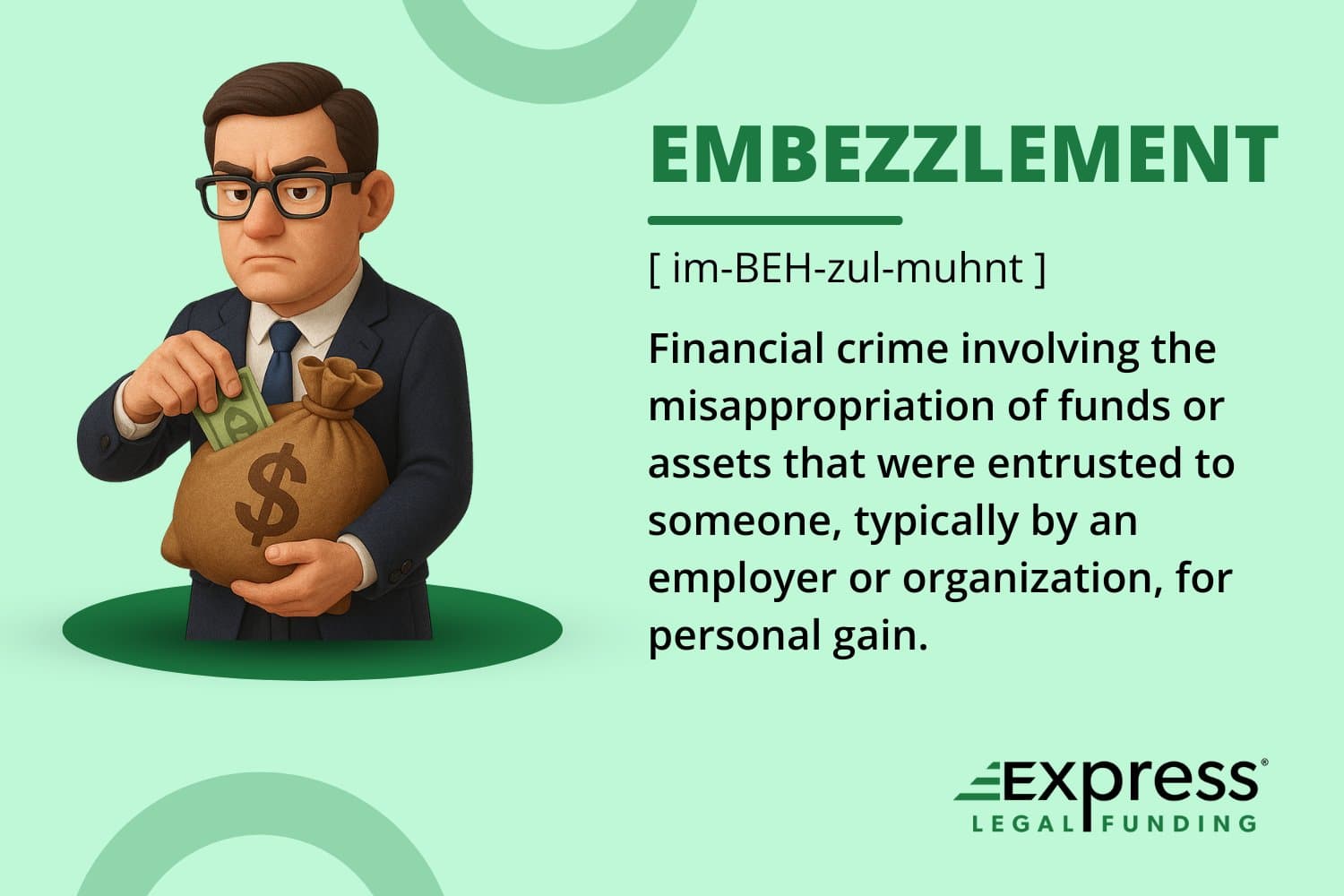Embezzlement is the unlawful misappropriation of money or property by a person entrusted to manage or oversee it.
Often arising in employment, fiduciary, or corporate settings, embezzlement involves a breach of trust where assets are diverted for personal use without authorization.
Understanding what constitutes embezzlement—and how it is defined and penalized by law—helps individuals, businesses, and legal professionals recognize warning signs, detect red flags early, and take preventive steps against financial misconduct.
What Is Embezzlement in Legal Terms?
Embezzlement is a white-collar crime that involves the unlawful taking or misappropriation of money or property by someone who was entrusted to manage or monitor it. What sets embezzlement apart from ordinary theft is that the individual had lawful access to the property but used it illegally for personal gain.
Typically, embezzlement occurs in employer-employee relationships, such as when a bookkeeper, manager, or fiduciary diverts company funds for unauthorized use. The offender abuses a position of trust, which is a key legal element of the crime.

Under U.S. criminal law, embezzlement is prosecuted as either a misdemeanor or felony, depending on the value of the assets involved and applicable state or federal statutes.
Penalties may include:
- Incarceration (jail or prison)
- Fines and court costs
- Probation or supervised release
- Restitution to the victim
- Permanent criminal record
- Professional consequences (e.g., job loss, licensing revocation)
What Is the Difference Between Embezzlement and Theft?
The key difference between embezzlement and theft lies in how the offender obtained access to the property.
- Embezzlement occurs when a person legally accesses money or property but then misuses or redirects it for personal gain. It involves a breach of trust—common in employer-employee or fiduciary relationships.
- Theft (or larceny) involves unlawfully taking property without consent, with no legal access or permission to possess it in the first place.
For example, if an accountant transfers company funds to their own account, it’s embezzlement. If someone breaks into an office and steals cash from a safe, that’s theft.
Both are crimes, but embezzlement typically involves trusted positions and often leads to separate charges or sentencing under specific statutes.
The History and Evolution of Embezzlement Laws
Embezzlement was originally treated as a form of theft, with no legal distinction between the two. Over time, as commercial and fiduciary relationships evolved, lawmakers recognized the need to address embezzlement as a separate crime involving abuse of trust rather than outright theft.
Key Legal Milestones:
- 1566 (England): The Act for the Punishment of Deceitful and Fraudulent Practices laid the groundwork for addressing trust-based financial crimes.
- 1861 (England): The Larceny Act formally distinguished embezzlement from larceny, defining it as a separate offense under British law.
- 1952 (United States): In Morissette v. United States, the U.S. Supreme Court ruled that criminal intent (mens rea) is essential for an embezzlement conviction, reinforcing the importance of deliberate misuse over accidental mishandling.
- 1962: The Federal Bank Fraud Statute expanded federal jurisdiction over embezzlement involving financial institutions.
- 2002: The Sarbanes-Oxley Act, passed after major corporate scandals (e.g., Enron, WorldCom), introduced stricter regulations and criminal penalties for corporate fraud and embezzlement.
These milestones reflect the legal system’s increasing emphasis on fiduciary responsibility, financial transparency, and protecting public trust in both government and private institutions.
Is Embezzlement a Federal Crime?
Yes, embezzlement can be a federal crime if it involves federal funds, crosses state lines, or occurs within federally regulated institutions. Under Title 18 of the U.S. Code, embezzlement is criminalized in various forms, including:
- 18 U.S.C. § 641: Theft or embezzlement of public money, property, or records.
- 18 U.S.C. § 656: Embezzlement by bank employees or officers of federally insured institutions.
- 18 U.S.C. § 666: Theft or bribery involving programs receiving federal funds, including embezzlement from government contractors or nonprofits.
Federal prosecution typically applies when the crime affects federal agencies, interstate commerce, or financial institutions regulated by federal law. Penalties can include up to 30 years in prison, hefty fines, and restitution.
If the embezzlement occurs entirely within a single state and doesn’t involve federal interests, it is usually prosecuted under state law instead.
Legal Consequences of Embezzlement
Embezzlement is a serious criminal offense that carries both criminal and civil penalties. The severity of consequences depends on factors such as the amount stolen, whether the offender has prior convictions, and the laws of the specific jurisdiction (state or federal).
Common Legal Penalties for Embezzlement:
- Fines: Offenders may face fines ranging from several thousand to millions of dollars, particularly in large-scale cases.
- Imprisonment: Embezzlement may be charged as a misdemeanor or felony. Felony convictions can result in multi-year prison sentences, often up to 20 years in federal court.
- Restitution: Courts frequently order convicted individuals to repay stolen funds to victims or organizations.
- Probation: Instead of or following incarceration, probation may include restricted financial activity, regular check-ins, and court supervision.
- Fraud Prevention Orders: Courts can issue orders that prohibit the offender from working in roles involving money handling, such as accounting or financial oversight.
Beyond legal penalties, an embezzlement conviction can lead to long-term reputational damage, loss of professional licenses, and barriers to employment in finance, public service, and positions of trust.
Can You Sue for Embezzlement?
Yes, you can sue for embezzlement through a civil lawsuit to recover stolen funds or property. While embezzlement is a criminal offense prosecuted by the state, victims also have the right to file a civil claim for damages, separate from the criminal case.
A civil lawsuit for embezzlement may seek:
- Monetary compensation (restitution)
- Punitive damages in cases of willful misconduct
- Legal fees and court costs
Victims can be:
- Employers
- Business partners
- Nonprofits
- Government entities
- Individuals acting through a power of attorney or trust
To succeed in civil court, the plaintiff must prove that the defendant intentionally misused entrusted property and caused financial harm. A criminal conviction is not required to win a civil case, though it can strengthen the plaintiff’s position.
How Is Embezzlement Proven in Court?
To prove embezzlement in court, prosecutors must establish specific legal elements beyond a reasonable doubt. These generally include:
- A fiduciary or trust-based relationship: The defendant was entrusted with money, property, or assets.
- Lawful access, not ownership: The defendant had authorized access—but not legal ownership—of the funds or property.
- Fraudulent intent: The defendant intentionally took, used, or misappropriated the property for personal gain.
- Conversion of property: The defendant’s actions deprived the rightful owner of their property.
- Lack of consent: The misuse was unauthorized by the owner or employer.
Evidence may include financial records, internal audits, emails, surveillance footage, and witness testimony. Prosecutors must also disprove common defenses, such as mistake, accident, or lack of intent.
Defense Strategies in Embezzlement Cases
Individuals accused of embezzlement may raise legal defenses to fight the charges, reduce penalties, or seek case dismissal. The viability of a defense depends on the facts, evidence, and jurisdictional law.
Common Embezzlement Defense Strategies:
- Lack of Intent: Embezzlement is an intentional crime. The defense may argue that the accused did not knowingly misuse funds, but acted due to mistake, negligence, or misunderstanding.
- Insufficient Evidence: If the prosecution cannot provide clear proof that funds were misappropriated and the defendant is responsible, charges may be dropped or dismissed.
- Entrapment: This defense applies if the defendant was induced or coerced by law enforcement or another party to commit the crime, and would not have done so otherwise.
- Duress: The defense may claim the accused was forced to embezzle under threat of harm, undermining the voluntary nature of the crime.
- Incapacity or Insanity: Arguing the defendant lacked mental capacity at the time of the offense, which prevented them from forming the intent required for a conviction.
Defense strategies must be carefully tailored to each case. An experienced criminal defense attorney can assess evidence, challenge procedural errors, and present arguments that align with state or federal law.
Varieties of Embezzlement: From Small Businesses to Large Corporations
Embezzlement can occur in any organization where individuals are entrusted with money or property, including small businesses, large corporations, government agencies, and nonprofit groups. While the scale and sophistication of schemes may vary, all forms involve the unauthorized diversion of entrusted assets for personal gain.
Common Types of Embezzlement:
- Skimming: Taking cash before it is recorded in the company’s books or point-of-sale system.
- Billing Schemes: Submitting false or inflated invoices and diverting payments to fake vendors or personal accounts.
- Check Tampering: Forging, altering, or intercepting company checks for unauthorized payments.
- Payroll Fraud: Overstating hours worked, inflating salaries, or creating non-existent “ghost” employees to collect wages.
- Expense Reimbursement Fraud: Claiming personal expenses as business-related or submitting fake receipts.
In corporate environments, embezzlement often includes falsifying accounting records, manipulating financial statements, or concealing losses. In nonprofits, misuse of grant funds, donations, or restricted accounts can lead to criminal charges, civil penalties, and a severe loss of public trust.
Real-Life Embezzlement Cases
Embezzlement cases vary widely in scale, from high-profile financial crimes to smaller, local incidents. Each case involves a serious breach of trust and highlights vulnerabilities in oversight and internal controls.
Notable Embezzlement Criminal Cases:
- Bernie Madoff (U.S., 2008): Though best known as a massive Ponzi scheme, Madoff’s fraud included embezzling billions in client funds through fake investment returns. He was sentenced to 150 years in prison. The case revealed major failures in regulatory oversight by the SEC and other watchdogs.
- Rita Crundwell (Dixon, Illinois, 2012): As city comptroller, Crundwell embezzled $53.7 million from municipal accounts over 20 years. She created a secret bank account under the city’s name and used it to fund a lavish lifestyle, including luxury horses and travel. It is one of the largest municipal embezzlement cases in U.S. history.
- Brenda Heistand (Ohio, 2020): Heistand, a bookkeeper for a small construction company in Newark, Ohio, was convicted of embezzling over $1 million across a 14-year period. She forged checks and altered accounting records to conceal the theft, using the funds to pay personal credit card bills and make unauthorized purchases. Her case shows how long-term embezzlement can occur undetected in small businesses lacking strong internal controls.
These real-world examples show that embezzlement can occur in any organization, public or private, and often goes undetected for years without strong financial controls and audits.

